Analyzing the Economic and Environmental Impact of Food Wastage
VerifiedAdded on 2022/09/14
|8
|1643
|24
Report
AI Summary
This report provides a detailed analysis of the economic and environmental implications of food wastage, highlighting the significant global concern due to a lack of understanding of its scale and impact. The author reflects on personal contributions to food wastage, categorizing it into avoidable and unavoidable waste. The report presents statistics on the environmental and economic impacts of wastage, including waste management costs, resource losses, and greenhouse gas emissions. Recommendations are offered, such as preparing meal plans, proper storage, directing unavoidable waste appropriately, and fostering collaboration among businesses, households, and governments. The report concludes that addressing food wastage requires collaborative efforts and strategic consumption to mitigate its negative effects on the environment, economy, and food affordability.
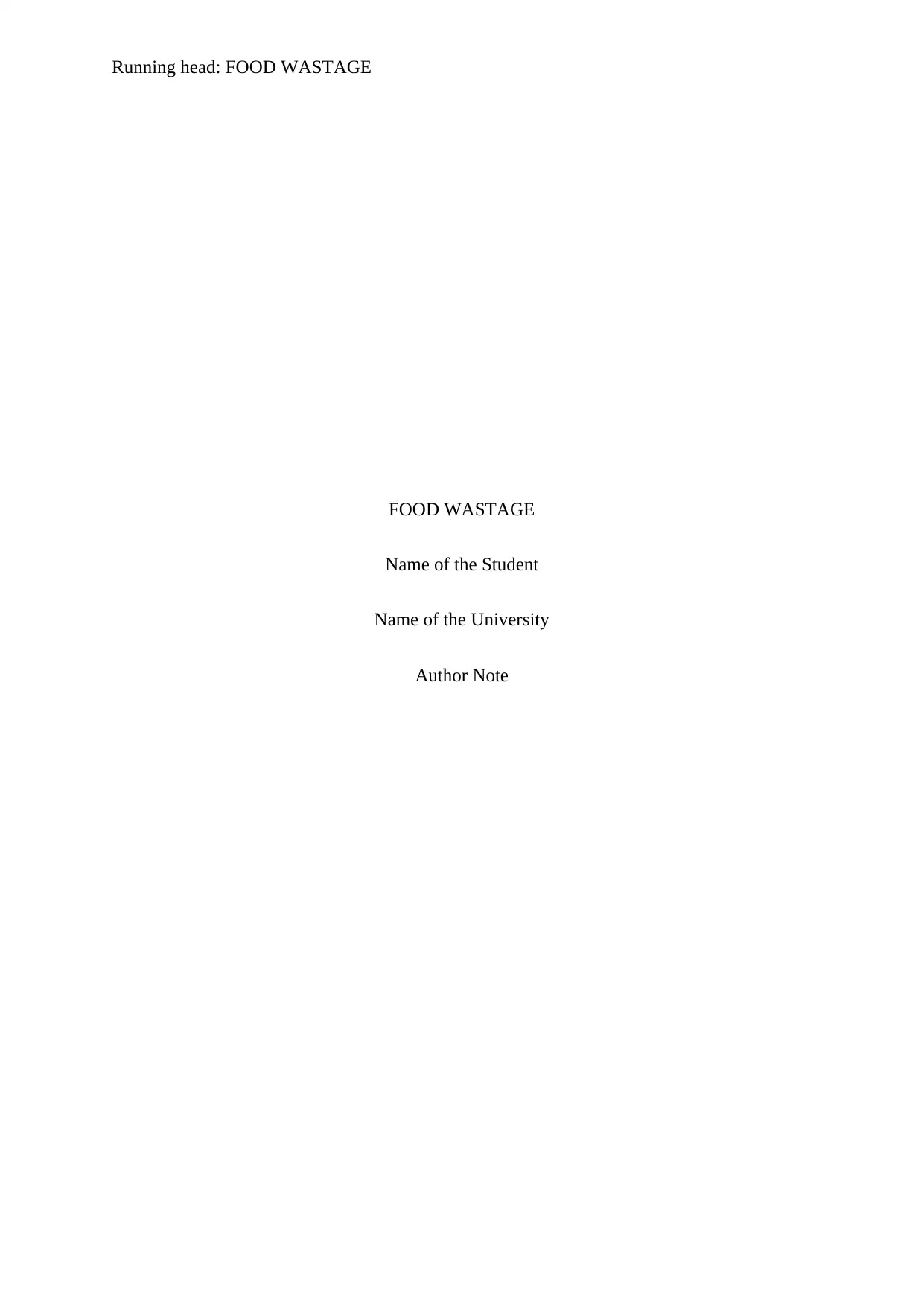
Running head: FOOD WASTAGE
FOOD WASTAGE
Name of the Student
Name of the University
Author Note
FOOD WASTAGE
Name of the Student
Name of the University
Author Note
Paraphrase This Document
Need a fresh take? Get an instant paraphrase of this document with our AI Paraphraser
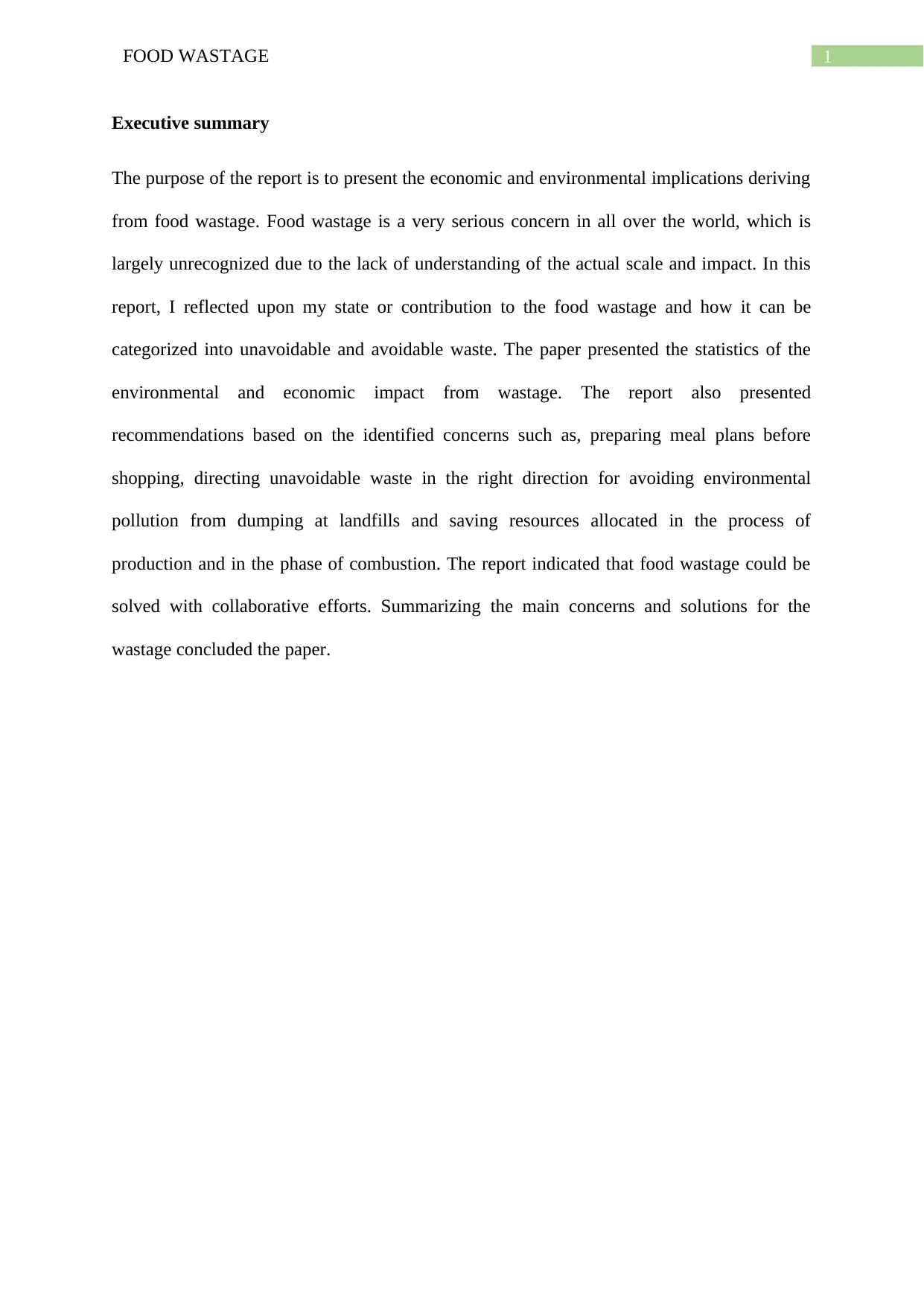
1FOOD WASTAGE
Executive summary
The purpose of the report is to present the economic and environmental implications deriving
from food wastage. Food wastage is a very serious concern in all over the world, which is
largely unrecognized due to the lack of understanding of the actual scale and impact. In this
report, I reflected upon my state or contribution to the food wastage and how it can be
categorized into unavoidable and avoidable waste. The paper presented the statistics of the
environmental and economic impact from wastage. The report also presented
recommendations based on the identified concerns such as, preparing meal plans before
shopping, directing unavoidable waste in the right direction for avoiding environmental
pollution from dumping at landfills and saving resources allocated in the process of
production and in the phase of combustion. The report indicated that food wastage could be
solved with collaborative efforts. Summarizing the main concerns and solutions for the
wastage concluded the paper.
Executive summary
The purpose of the report is to present the economic and environmental implications deriving
from food wastage. Food wastage is a very serious concern in all over the world, which is
largely unrecognized due to the lack of understanding of the actual scale and impact. In this
report, I reflected upon my state or contribution to the food wastage and how it can be
categorized into unavoidable and avoidable waste. The paper presented the statistics of the
environmental and economic impact from wastage. The report also presented
recommendations based on the identified concerns such as, preparing meal plans before
shopping, directing unavoidable waste in the right direction for avoiding environmental
pollution from dumping at landfills and saving resources allocated in the process of
production and in the phase of combustion. The report indicated that food wastage could be
solved with collaborative efforts. Summarizing the main concerns and solutions for the
wastage concluded the paper.
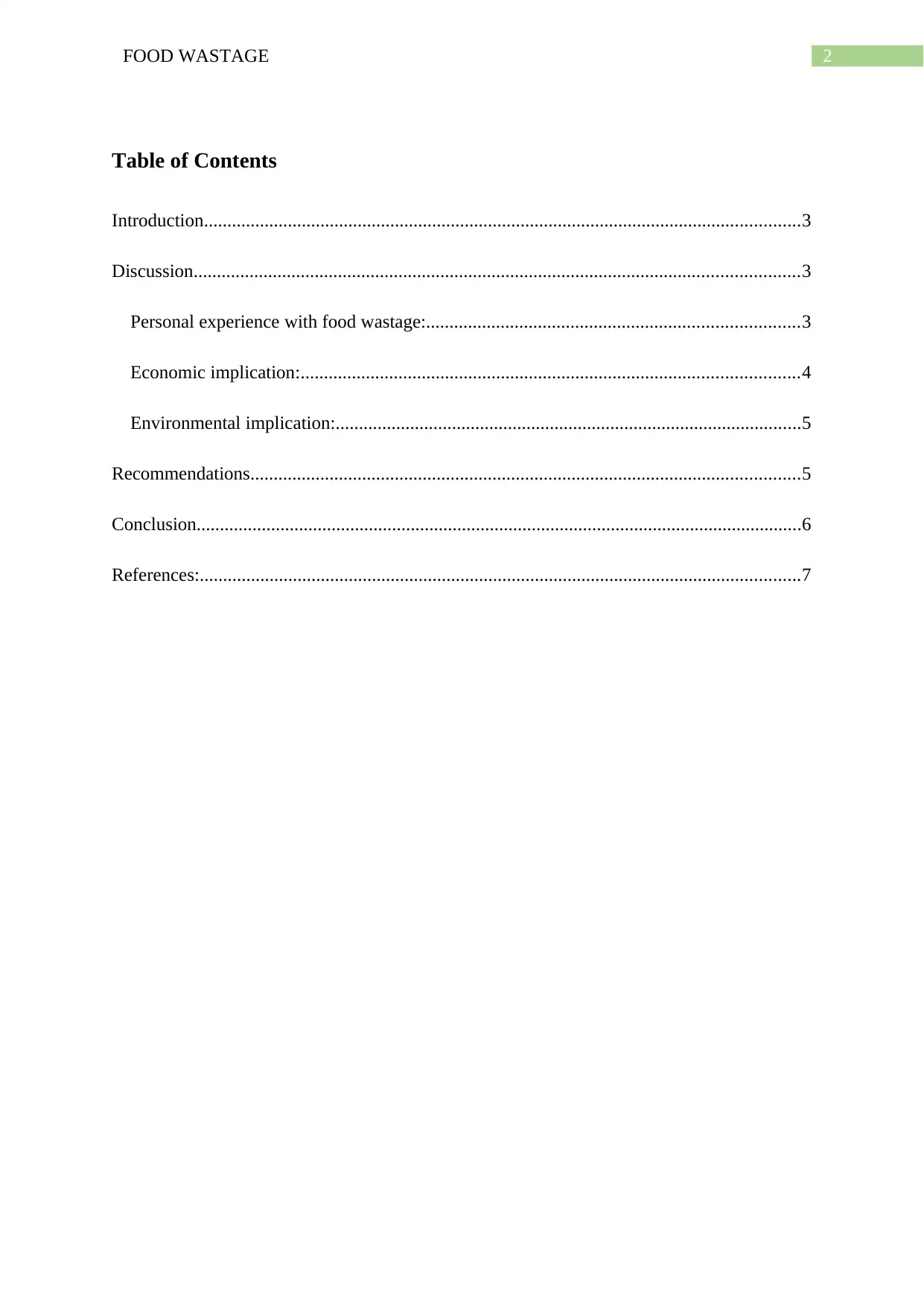
2FOOD WASTAGE
Table of Contents
Introduction................................................................................................................................3
Discussion..................................................................................................................................3
Personal experience with food wastage:................................................................................3
Economic implication:...........................................................................................................4
Environmental implication:....................................................................................................5
Recommendations......................................................................................................................5
Conclusion..................................................................................................................................6
References:.................................................................................................................................7
Table of Contents
Introduction................................................................................................................................3
Discussion..................................................................................................................................3
Personal experience with food wastage:................................................................................3
Economic implication:...........................................................................................................4
Environmental implication:....................................................................................................5
Recommendations......................................................................................................................5
Conclusion..................................................................................................................................6
References:.................................................................................................................................7
⊘ This is a preview!⊘
Do you want full access?
Subscribe today to unlock all pages.

Trusted by 1+ million students worldwide
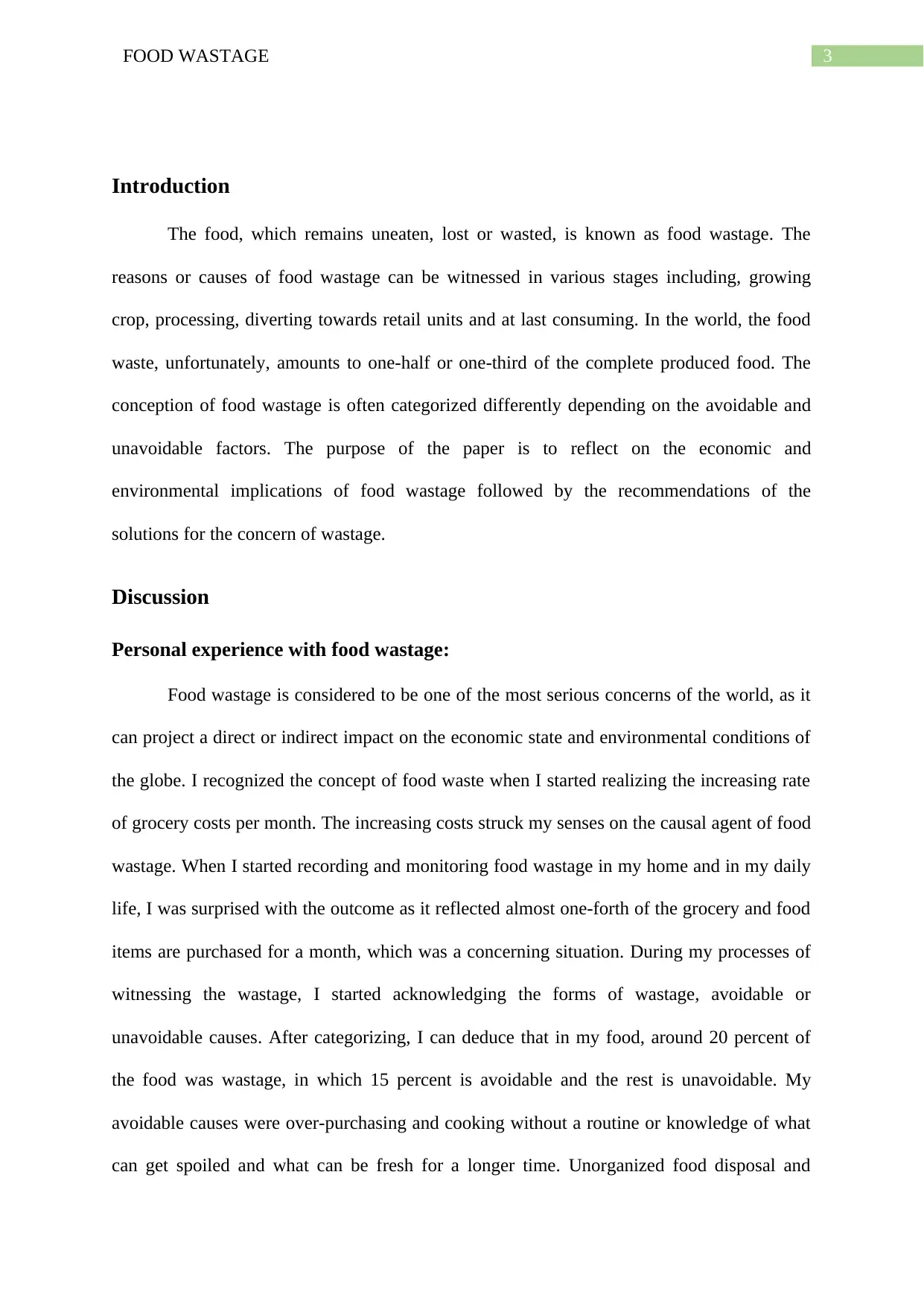
3FOOD WASTAGE
Introduction
The food, which remains uneaten, lost or wasted, is known as food wastage. The
reasons or causes of food wastage can be witnessed in various stages including, growing
crop, processing, diverting towards retail units and at last consuming. In the world, the food
waste, unfortunately, amounts to one-half or one-third of the complete produced food. The
conception of food wastage is often categorized differently depending on the avoidable and
unavoidable factors. The purpose of the paper is to reflect on the economic and
environmental implications of food wastage followed by the recommendations of the
solutions for the concern of wastage.
Discussion
Personal experience with food wastage:
Food wastage is considered to be one of the most serious concerns of the world, as it
can project a direct or indirect impact on the economic state and environmental conditions of
the globe. I recognized the concept of food waste when I started realizing the increasing rate
of grocery costs per month. The increasing costs struck my senses on the causal agent of food
wastage. When I started recording and monitoring food wastage in my home and in my daily
life, I was surprised with the outcome as it reflected almost one-forth of the grocery and food
items are purchased for a month, which was a concerning situation. During my processes of
witnessing the wastage, I started acknowledging the forms of wastage, avoidable or
unavoidable causes. After categorizing, I can deduce that in my food, around 20 percent of
the food was wastage, in which 15 percent is avoidable and the rest is unavoidable. My
avoidable causes were over-purchasing and cooking without a routine or knowledge of what
can get spoiled and what can be fresh for a longer time. Unorganized food disposal and
Introduction
The food, which remains uneaten, lost or wasted, is known as food wastage. The
reasons or causes of food wastage can be witnessed in various stages including, growing
crop, processing, diverting towards retail units and at last consuming. In the world, the food
waste, unfortunately, amounts to one-half or one-third of the complete produced food. The
conception of food wastage is often categorized differently depending on the avoidable and
unavoidable factors. The purpose of the paper is to reflect on the economic and
environmental implications of food wastage followed by the recommendations of the
solutions for the concern of wastage.
Discussion
Personal experience with food wastage:
Food wastage is considered to be one of the most serious concerns of the world, as it
can project a direct or indirect impact on the economic state and environmental conditions of
the globe. I recognized the concept of food waste when I started realizing the increasing rate
of grocery costs per month. The increasing costs struck my senses on the causal agent of food
wastage. When I started recording and monitoring food wastage in my home and in my daily
life, I was surprised with the outcome as it reflected almost one-forth of the grocery and food
items are purchased for a month, which was a concerning situation. During my processes of
witnessing the wastage, I started acknowledging the forms of wastage, avoidable or
unavoidable causes. After categorizing, I can deduce that in my food, around 20 percent of
the food was wastage, in which 15 percent is avoidable and the rest is unavoidable. My
avoidable causes were over-purchasing and cooking without a routine or knowledge of what
can get spoiled and what can be fresh for a longer time. Unorganized food disposal and
Paraphrase This Document
Need a fresh take? Get an instant paraphrase of this document with our AI Paraphraser
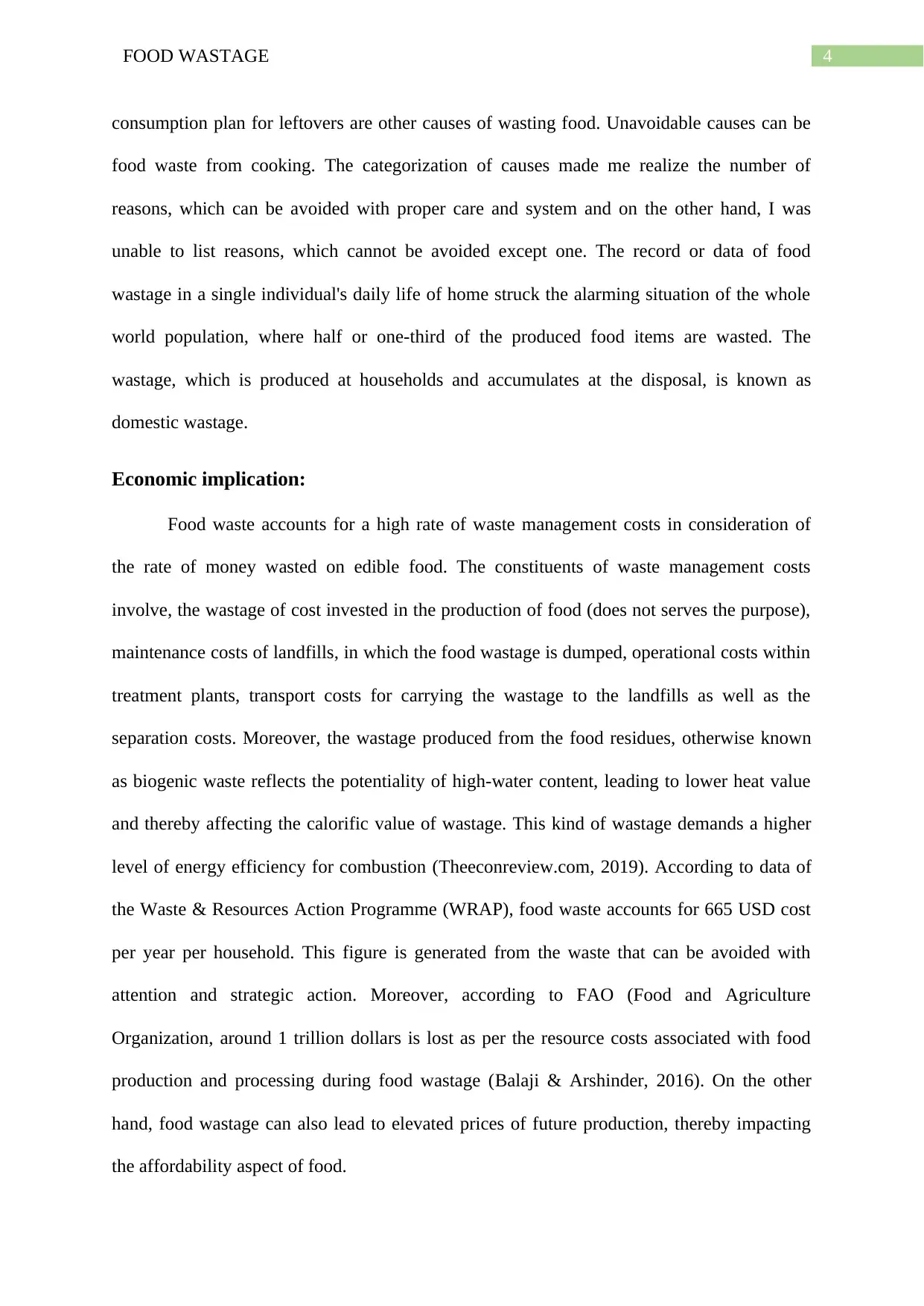
4FOOD WASTAGE
consumption plan for leftovers are other causes of wasting food. Unavoidable causes can be
food waste from cooking. The categorization of causes made me realize the number of
reasons, which can be avoided with proper care and system and on the other hand, I was
unable to list reasons, which cannot be avoided except one. The record or data of food
wastage in a single individual's daily life of home struck the alarming situation of the whole
world population, where half or one-third of the produced food items are wasted. The
wastage, which is produced at households and accumulates at the disposal, is known as
domestic wastage.
Economic implication:
Food waste accounts for a high rate of waste management costs in consideration of
the rate of money wasted on edible food. The constituents of waste management costs
involve, the wastage of cost invested in the production of food (does not serves the purpose),
maintenance costs of landfills, in which the food wastage is dumped, operational costs within
treatment plants, transport costs for carrying the wastage to the landfills as well as the
separation costs. Moreover, the wastage produced from the food residues, otherwise known
as biogenic waste reflects the potentiality of high-water content, leading to lower heat value
and thereby affecting the calorific value of wastage. This kind of wastage demands a higher
level of energy efficiency for combustion (Theeconreview.com, 2019). According to data of
the Waste & Resources Action Programme (WRAP), food waste accounts for 665 USD cost
per year per household. This figure is generated from the waste that can be avoided with
attention and strategic action. Moreover, according to FAO (Food and Agriculture
Organization, around 1 trillion dollars is lost as per the resource costs associated with food
production and processing during food wastage (Balaji & Arshinder, 2016). On the other
hand, food wastage can also lead to elevated prices of future production, thereby impacting
the affordability aspect of food.
consumption plan for leftovers are other causes of wasting food. Unavoidable causes can be
food waste from cooking. The categorization of causes made me realize the number of
reasons, which can be avoided with proper care and system and on the other hand, I was
unable to list reasons, which cannot be avoided except one. The record or data of food
wastage in a single individual's daily life of home struck the alarming situation of the whole
world population, where half or one-third of the produced food items are wasted. The
wastage, which is produced at households and accumulates at the disposal, is known as
domestic wastage.
Economic implication:
Food waste accounts for a high rate of waste management costs in consideration of
the rate of money wasted on edible food. The constituents of waste management costs
involve, the wastage of cost invested in the production of food (does not serves the purpose),
maintenance costs of landfills, in which the food wastage is dumped, operational costs within
treatment plants, transport costs for carrying the wastage to the landfills as well as the
separation costs. Moreover, the wastage produced from the food residues, otherwise known
as biogenic waste reflects the potentiality of high-water content, leading to lower heat value
and thereby affecting the calorific value of wastage. This kind of wastage demands a higher
level of energy efficiency for combustion (Theeconreview.com, 2019). According to data of
the Waste & Resources Action Programme (WRAP), food waste accounts for 665 USD cost
per year per household. This figure is generated from the waste that can be avoided with
attention and strategic action. Moreover, according to FAO (Food and Agriculture
Organization, around 1 trillion dollars is lost as per the resource costs associated with food
production and processing during food wastage (Balaji & Arshinder, 2016). On the other
hand, food wastage can also lead to elevated prices of future production, thereby impacting
the affordability aspect of food.
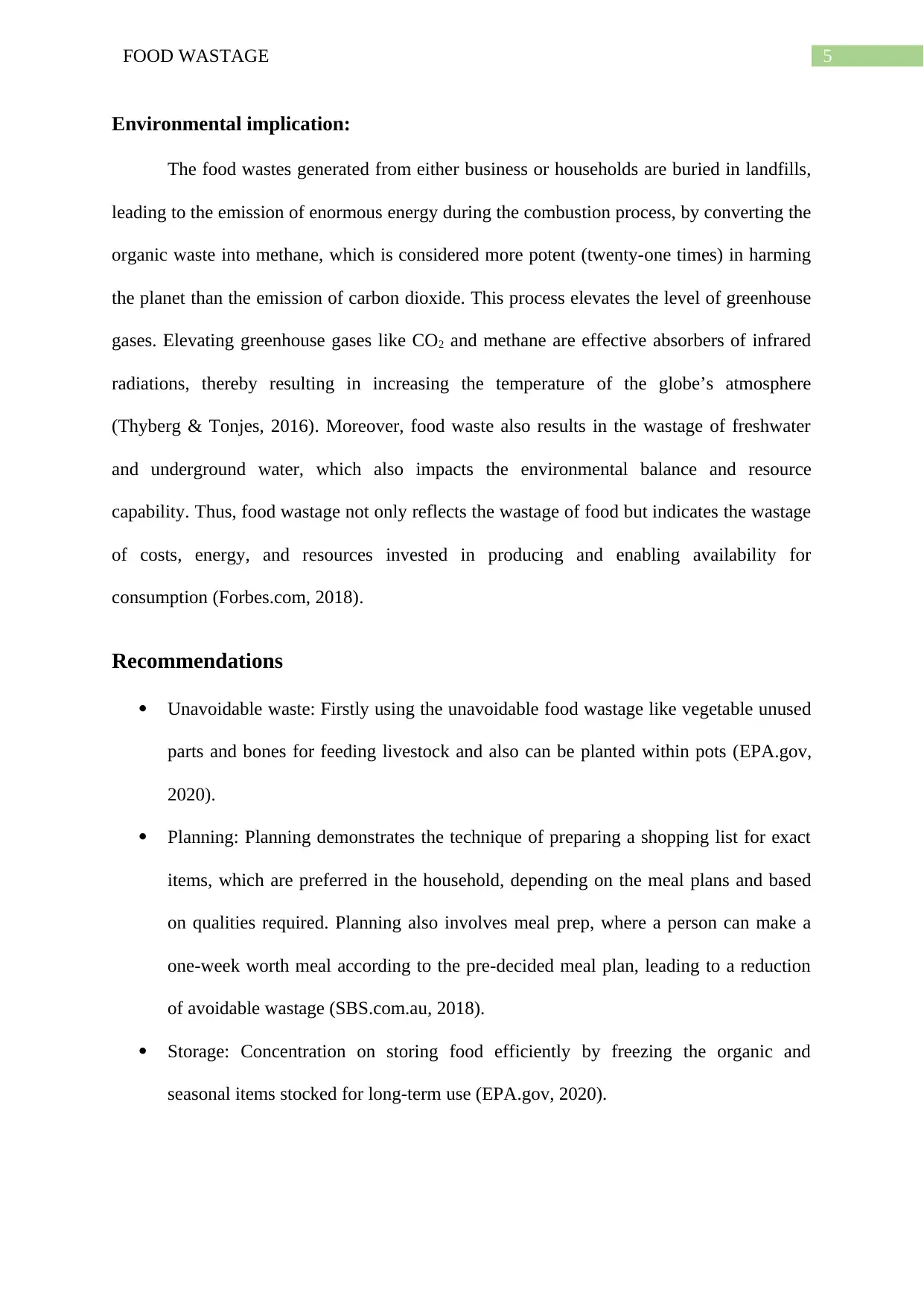
5FOOD WASTAGE
Environmental implication:
The food wastes generated from either business or households are buried in landfills,
leading to the emission of enormous energy during the combustion process, by converting the
organic waste into methane, which is considered more potent (twenty-one times) in harming
the planet than the emission of carbon dioxide. This process elevates the level of greenhouse
gases. Elevating greenhouse gases like CO2 and methane are effective absorbers of infrared
radiations, thereby resulting in increasing the temperature of the globe’s atmosphere
(Thyberg & Tonjes, 2016). Moreover, food waste also results in the wastage of freshwater
and underground water, which also impacts the environmental balance and resource
capability. Thus, food wastage not only reflects the wastage of food but indicates the wastage
of costs, energy, and resources invested in producing and enabling availability for
consumption (Forbes.com, 2018).
Recommendations
Unavoidable waste: Firstly using the unavoidable food wastage like vegetable unused
parts and bones for feeding livestock and also can be planted within pots (EPA.gov,
2020).
Planning: Planning demonstrates the technique of preparing a shopping list for exact
items, which are preferred in the household, depending on the meal plans and based
on qualities required. Planning also involves meal prep, where a person can make a
one-week worth meal according to the pre-decided meal plan, leading to a reduction
of avoidable wastage (SBS.com.au, 2018).
Storage: Concentration on storing food efficiently by freezing the organic and
seasonal items stocked for long-term use (EPA.gov, 2020).
Environmental implication:
The food wastes generated from either business or households are buried in landfills,
leading to the emission of enormous energy during the combustion process, by converting the
organic waste into methane, which is considered more potent (twenty-one times) in harming
the planet than the emission of carbon dioxide. This process elevates the level of greenhouse
gases. Elevating greenhouse gases like CO2 and methane are effective absorbers of infrared
radiations, thereby resulting in increasing the temperature of the globe’s atmosphere
(Thyberg & Tonjes, 2016). Moreover, food waste also results in the wastage of freshwater
and underground water, which also impacts the environmental balance and resource
capability. Thus, food wastage not only reflects the wastage of food but indicates the wastage
of costs, energy, and resources invested in producing and enabling availability for
consumption (Forbes.com, 2018).
Recommendations
Unavoidable waste: Firstly using the unavoidable food wastage like vegetable unused
parts and bones for feeding livestock and also can be planted within pots (EPA.gov,
2020).
Planning: Planning demonstrates the technique of preparing a shopping list for exact
items, which are preferred in the household, depending on the meal plans and based
on qualities required. Planning also involves meal prep, where a person can make a
one-week worth meal according to the pre-decided meal plan, leading to a reduction
of avoidable wastage (SBS.com.au, 2018).
Storage: Concentration on storing food efficiently by freezing the organic and
seasonal items stocked for long-term use (EPA.gov, 2020).
⊘ This is a preview!⊘
Do you want full access?
Subscribe today to unlock all pages.

Trusted by 1+ million students worldwide
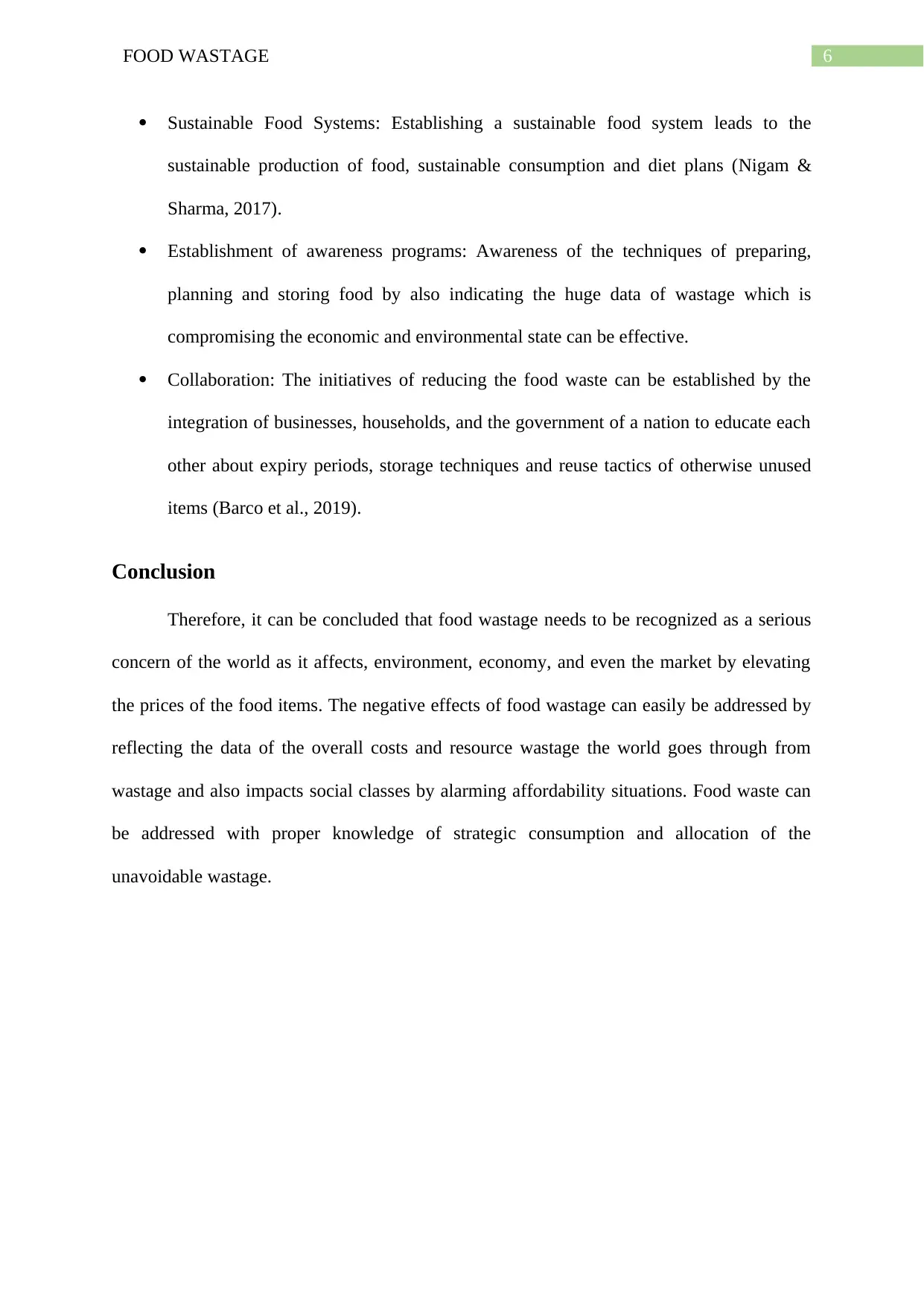
6FOOD WASTAGE
Sustainable Food Systems: Establishing a sustainable food system leads to the
sustainable production of food, sustainable consumption and diet plans (Nigam &
Sharma, 2017).
Establishment of awareness programs: Awareness of the techniques of preparing,
planning and storing food by also indicating the huge data of wastage which is
compromising the economic and environmental state can be effective.
Collaboration: The initiatives of reducing the food waste can be established by the
integration of businesses, households, and the government of a nation to educate each
other about expiry periods, storage techniques and reuse tactics of otherwise unused
items (Barco et al., 2019).
Conclusion
Therefore, it can be concluded that food wastage needs to be recognized as a serious
concern of the world as it affects, environment, economy, and even the market by elevating
the prices of the food items. The negative effects of food wastage can easily be addressed by
reflecting the data of the overall costs and resource wastage the world goes through from
wastage and also impacts social classes by alarming affordability situations. Food waste can
be addressed with proper knowledge of strategic consumption and allocation of the
unavoidable wastage.
Sustainable Food Systems: Establishing a sustainable food system leads to the
sustainable production of food, sustainable consumption and diet plans (Nigam &
Sharma, 2017).
Establishment of awareness programs: Awareness of the techniques of preparing,
planning and storing food by also indicating the huge data of wastage which is
compromising the economic and environmental state can be effective.
Collaboration: The initiatives of reducing the food waste can be established by the
integration of businesses, households, and the government of a nation to educate each
other about expiry periods, storage techniques and reuse tactics of otherwise unused
items (Barco et al., 2019).
Conclusion
Therefore, it can be concluded that food wastage needs to be recognized as a serious
concern of the world as it affects, environment, economy, and even the market by elevating
the prices of the food items. The negative effects of food wastage can easily be addressed by
reflecting the data of the overall costs and resource wastage the world goes through from
wastage and also impacts social classes by alarming affordability situations. Food waste can
be addressed with proper knowledge of strategic consumption and allocation of the
unavoidable wastage.
Paraphrase This Document
Need a fresh take? Get an instant paraphrase of this document with our AI Paraphraser
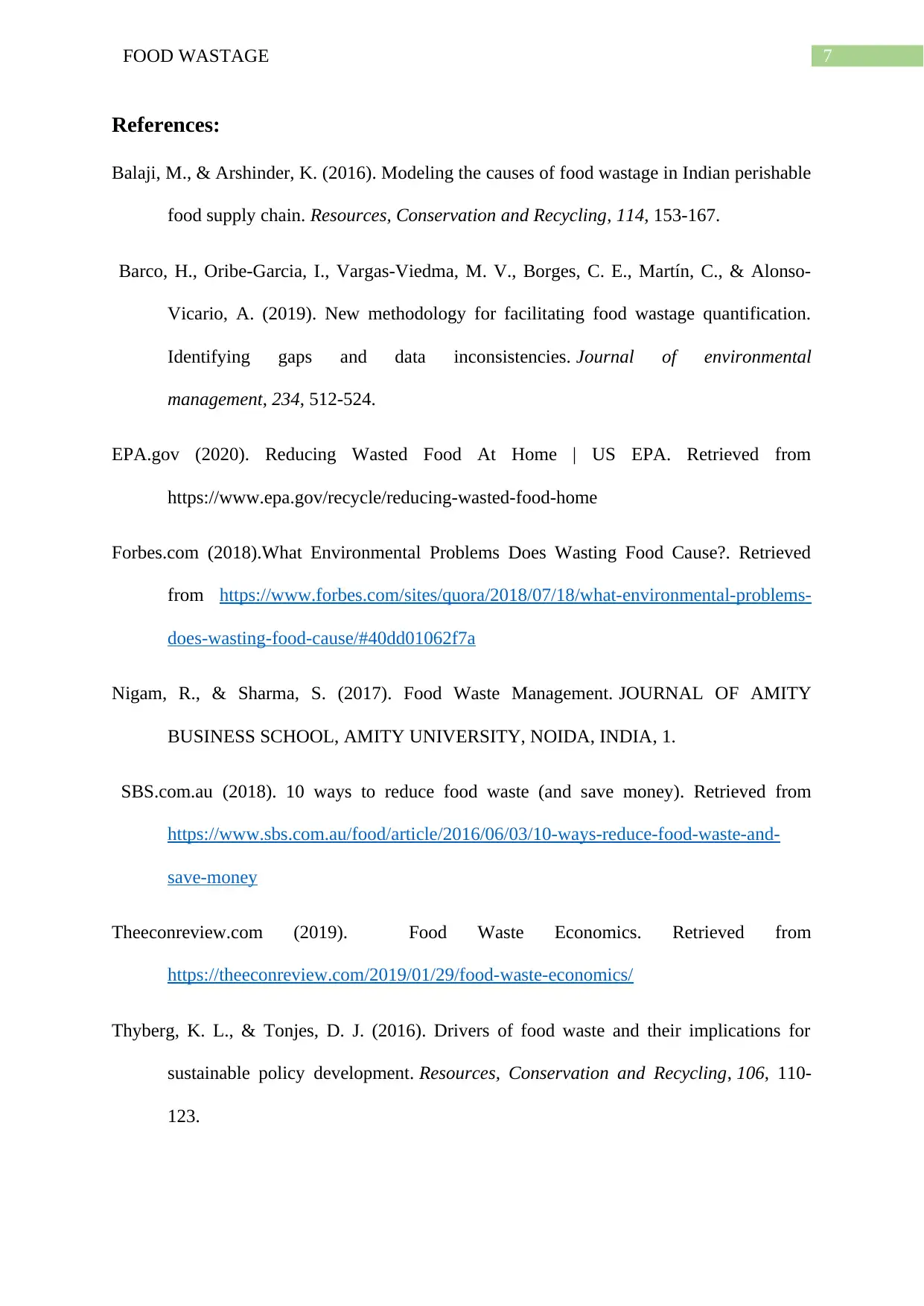
7FOOD WASTAGE
References:
Balaji, M., & Arshinder, K. (2016). Modeling the causes of food wastage in Indian perishable
food supply chain. Resources, Conservation and Recycling, 114, 153-167.
Barco, H., Oribe-Garcia, I., Vargas-Viedma, M. V., Borges, C. E., Martín, C., & Alonso-
Vicario, A. (2019). New methodology for facilitating food wastage quantification.
Identifying gaps and data inconsistencies. Journal of environmental
management, 234, 512-524.
EPA.gov (2020). Reducing Wasted Food At Home | US EPA. Retrieved from
https://www.epa.gov/recycle/reducing-wasted-food-home
Forbes.com (2018).What Environmental Problems Does Wasting Food Cause?. Retrieved
from https://www.forbes.com/sites/quora/2018/07/18/what-environmental-problems-
does-wasting-food-cause/#40dd01062f7a
Nigam, R., & Sharma, S. (2017). Food Waste Management. JOURNAL OF AMITY
BUSINESS SCHOOL, AMITY UNIVERSITY, NOIDA, INDIA, 1.
SBS.com.au (2018). 10 ways to reduce food waste (and save money). Retrieved from
https://www.sbs.com.au/food/article/2016/06/03/10-ways-reduce-food-waste-and-
save-money
Theeconreview.com (2019). Food Waste Economics. Retrieved from
https://theeconreview.com/2019/01/29/food-waste-economics/
Thyberg, K. L., & Tonjes, D. J. (2016). Drivers of food waste and their implications for
sustainable policy development. Resources, Conservation and Recycling, 106, 110-
123.
References:
Balaji, M., & Arshinder, K. (2016). Modeling the causes of food wastage in Indian perishable
food supply chain. Resources, Conservation and Recycling, 114, 153-167.
Barco, H., Oribe-Garcia, I., Vargas-Viedma, M. V., Borges, C. E., Martín, C., & Alonso-
Vicario, A. (2019). New methodology for facilitating food wastage quantification.
Identifying gaps and data inconsistencies. Journal of environmental
management, 234, 512-524.
EPA.gov (2020). Reducing Wasted Food At Home | US EPA. Retrieved from
https://www.epa.gov/recycle/reducing-wasted-food-home
Forbes.com (2018).What Environmental Problems Does Wasting Food Cause?. Retrieved
from https://www.forbes.com/sites/quora/2018/07/18/what-environmental-problems-
does-wasting-food-cause/#40dd01062f7a
Nigam, R., & Sharma, S. (2017). Food Waste Management. JOURNAL OF AMITY
BUSINESS SCHOOL, AMITY UNIVERSITY, NOIDA, INDIA, 1.
SBS.com.au (2018). 10 ways to reduce food waste (and save money). Retrieved from
https://www.sbs.com.au/food/article/2016/06/03/10-ways-reduce-food-waste-and-
save-money
Theeconreview.com (2019). Food Waste Economics. Retrieved from
https://theeconreview.com/2019/01/29/food-waste-economics/
Thyberg, K. L., & Tonjes, D. J. (2016). Drivers of food waste and their implications for
sustainable policy development. Resources, Conservation and Recycling, 106, 110-
123.
1 out of 8
Related Documents
Your All-in-One AI-Powered Toolkit for Academic Success.
+13062052269
info@desklib.com
Available 24*7 on WhatsApp / Email
![[object Object]](/_next/static/media/star-bottom.7253800d.svg)
Unlock your academic potential
Copyright © 2020–2025 A2Z Services. All Rights Reserved. Developed and managed by ZUCOL.



